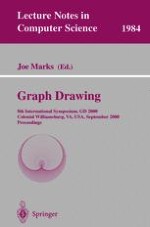This year’s meeting marked the Eighth International Symposium on Graph D- wing. The organizing and program committees worked hard to make this year’s symposium possible, and we were delighted that so many people came to - lonial Williamsburg, Virginia, for three days of the latest results in the eld of graph drawing. As in previous years, the review process was quite competitive. We accepted 30 out of 53 regular-length submissions, and 5 out of 15 short submissions, for a total acceptance ratio of 35 out of 68, or 51%. This year’s program featured several new developments in the eld. Four di erent approaches for handling very large graphs were presented in a session on force-directed layout. Two sessions were devoted to the latest advances in orthogonal graph drawing. And alongside the usual mix of theory and practice papers we had several contributions based on empirical studies of users and of systems. Our invited talks were given by two speakers who were new to most members of the GD community, but who work in areas that are closely related to graph drawing. Professor Colin Ware of the University of New Hampshire told us how knowledge of human visual perception is useful for the design of e ective data visualizations. And Professor David Jensen of the University of Massachusetts at Amherst talked about the process of knowledge discovery from graphs, a process that involves more than just graph drawing and visualization.
